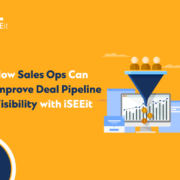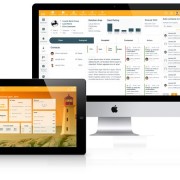How to Better Close Complex Deals
 Closing large deals is the World Cup of sales.
Closing large deals is the World Cup of sales.
Your first $1 million-dollar deal won’t let you sleep at night. You’ll be running in circles coordinating all of the people, tasks and information you need to close.
And it only gets worse as you get closer to D-Day, the final decision, where you find out if all your effort was worth it or not.
No matter how senior you are, large deals ask everything of you and change your life after your first big win. Your confidence, recognition, and compensation all transform overnight.
In our efforts to help sales professional everywhere, we have put together a summary of best practices that will help you close complex deals faster and more effectively.
The 3 P’s of Closing Complex Deals
Large deals increase not only the size of the close, but also the complexity. They often involve more decision makers, more criteria required for approval, and longer sales cycles.
In order to close a large deal effectively, you need to focus on three main things:
Pain, People and Planning
Cover these and you’re on track to closing any deal, whatever the size.
Let’s look at each one in more detail.
Pain
Understanding your client’s pain points is the crucial first step in any deal. These are the pitfalls and shortages that keep them from achieving the growth they are reaching for.
In times of budget cuts, reduced staff and limited appetite for more projects, prospective clients are facing all kinds of pains. And if you solve their pain in a way that closely aligns to your customer’s business, your deal is off to a solid start.
At the start of any deal, you want to make sure that you’ve answered these questions:
- What are the problems (pain points) my client is currently facing?
- Are they business relevant? What are the implications of those pains?
- What happens if those pains aren’t solved?
- Can I solve the pain with something I have to offer?
- Has the client confirmed the pain?
You might say, “Well, I’ve closed deals without knowing the pain, business relevance or implication.” However, somewhere along your client’s approval process, someone is going to ask:
Do we really need this? What if we don’t do anything now? Why should we prioritize this project?
Effective sales reps not only know the answers to these questions, they actually influence and help their clients address these points ahead of time in order to secure the opportunity.
People
Once you have a clear understanding of your client’s pain points, you need to know who is responsible for solving the pain and who is benefiting from the solution.
That’s when you start mapping an organizational chart. Look for potential allies within your client’s company that have a strong personal interest to solve the pain and have the power to drive the opportunity with them.
We call these allies, Champions (see our article, How to Identify a Champion).
Together with these champions, your next step is to identify and connect with those within the powerbase of the company. That is, with those who have the major influence over the final decision.
Here’s a quick checklist that will make sure you find the right people:
1. Go Wide
• Have you established contacts within the company’s different departments, or even different geographies? This will solidify company-wide support for your solution.
• Have you connected with multiple-decision makers and ensured their buy-in?
2. Go High
• Have you established champions within the executive level? This ensures a high-level of influence for you and your solution.
• Is the ultimate decision maker, the economic buyer, supporting the decision? If he doesn’t yet, find a way to convince him.
3. Bridge the Gaps
• Have you bridged the right people within your own company to theirs? Have you gotten your C-level execs to talk to their C-level execs? Your IT to their IT? Utilizing this kind of Multi-Level Selling will dramatically increase your chances of closing any large deal.
People are at the heart of every decision, which is why identifying and engaging with key influencers is a critical step to securing your close.
Planning
Begin with the end in mind. If you don’t, you’ll find yourself in crisis mode: fighting fires to keep your deal from falling apart instead driving it proactively.
This is especially true in large, complex deals, where many evaluators and decision makers are involved. That makes it critical for you to stay in control over the messaging and reasoning behind your deal.
This is when you need to have answers to The 3 Why’s:
1. Why do anything?
Why should the client take a decision? What happens if nothing happens? Would there be any consequences?
2. Why us?
What are you providing that the client sees as a unique value to them? What are the arguments that your Champion will use to defend your joint cause?
3. Why Now?
Is there any compelling reason for the client to take a decision within a given timeframe? If not, can you construct a compelling reason so the client aligns himself with this deadline?
Finding these answers will ensure that you have the necessary understanding of the value drivers behind your deal.
And while they may develop and evolve throughout your deal, by the final stages everyone, from your client’s side and yours, should be able to repeat these answers without thinking.
You’ll also need to work with your champion (or champions) and establish a detailed closing plan.
In addition to what we’ve covered, a solid closing plan should include:
- A clear route leads to getting the technical decisions made, get the budget approved and get the paperwork drawn
- Milestones that are aligned with your customer’s buying process and ensure that your deal is on track
- A timeline that you’ve reverse engineered from your deadlines back to today
- A Plan B, so you know what to do in case things go wrong (because they often do!)
The Benefits of The 3 P’s
Having a strong understanding of your client’s pain, great access to the people involved in the decision-making, and planning your sales process thoroughly will allow you to influence the outcome of your more than ever before.
You’ll have accounted for all the details, big and small, that often keep reps from closing complex deals.
Not only will you have less stress going in to the end of the quarter (and have a manager that’s thrilled with the accuracy of your forecasts), you’ll get to experience the high of closing a large deal − where the contract finally gets signed, the pressure is off, and you feel like you’re flying.
And once you master the 3 P’s, you’ll be experiencing that feeling over and over.













Your point of view caught my eye and was very interesting. Thanks. I have a question for you. https://www.binance.com/ka-GE/join?ref=RQUR4BEO
Your article helped me a lot, is there any more related content? Thanks!
cost generic clomiphene for sale can you buy cheap clomiphene pills how to buy clomid price where buy cheap clomiphene tablets clomiphene one fallopian tube clomiphene price uk buy clomiphene no prescription
Greetings! Utter useful advice within this article! It’s the little changes which wish obtain the largest changes. Thanks a a quantity towards sharing!
Greetings! Utter serviceable par‘nesis within this article! It’s the scarcely changes which will espy the largest changes. Thanks a portion quest of sharing!
buy zithromax 500mg generic – order tinidazole 500mg online cheap purchase metronidazole
brand rybelsus 14mg – buy cheap semaglutide cyproheptadine uk
motilium 10mg pill – buy generic tetracycline over the counter flexeril drug
inderal over the counter – brand methotrexate cheap methotrexate 10mg